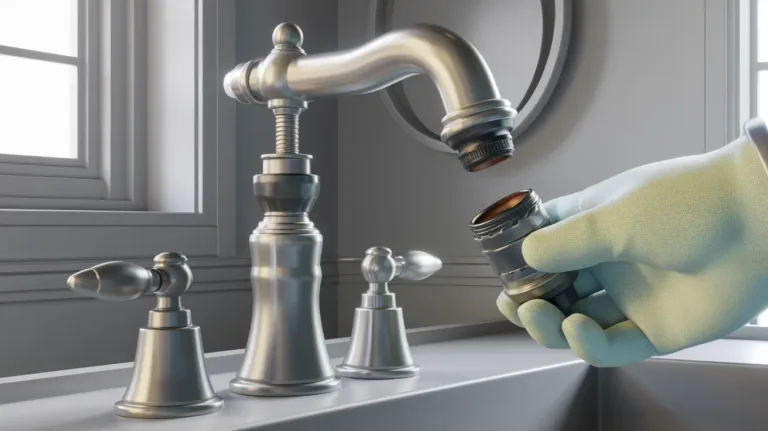When to Drip Faucets: Prevent Frozen Pipes
Leaving a faucet dripping might seem simple, but it can save you a lot of trouble. Burst pipes are a big problem when it gets cold, causing over $10,000 in damage for homeowners. For businesses, the damage can be even worse, sometimes reaching into the millions.
A dripping faucet can stop pipes from bursting. It does this by easing the pressure in the pipes. This pressure builds up when ice blocks the pipes. When the ice melts, the pressure can cause pipes to burst.
Key Takeaways
- Dripping faucets can prevent costly damage from frozen pipes
- Burst pipes are a common problem during freezing weather
- Dripping faucets relieve pressure in pipes to prevent bursting
- Homeowners face average claims of $10,000 for frozen pipe damage
- Businesses can see even higher claims, up to millions of dollars
Understanding the Dangers of Frozen Pipes
When it gets cold, frozen pipes become a big worry. Water expands when it freezes. This expansion puts a lot of pressure on pipes, whether they’re metal or plastic. No matter how strong, the water can burst the pipes, causing expensive damage.
Why Pipe Freezing is a Problem
Pipes most at risk are those outside in the cold, like hose bibs and sprinkler lines. Also, pipes in unheated areas like basements and attics are at risk. Pipes along exterior walls with little insulation are also at high risk of pipe bursting.
When a pipe freezes, ice blocks the flow, building up pressure. This pressure can cause the pipe to burst, leading to water damage. Fixing a burst pipe is expensive and time-consuming. It’s crucial to prevent frozen pipes to avoid these problems.
“The expansion of frozen water can exert pressure up to 2,000 pounds per square inch, which is enough to cause most residential pipes to burst.”
| Potential Dangers of Frozen Pipes | Impact |
|---|---|
| Pipe Bursting | Significant water damage, costly repairs |
| Water Damage | Damage to floors, walls, furniture, and personal belongings |
| Mold and Mildew Growth | Health hazards and structural damage |
| Loss of Access to Clean Water | Inconvenience and disruption to daily life |
Identifying High-Risk Areas for Frozen Pipes
Protecting your home from frozen pipes is key. You need to know where pipes are most at risk. Pipes in attics, garages, basements, or crawl spaces are more likely to freeze. This is because these areas usually have the same temperature as outside.
Pipes in basements, crawl spaces, attics, kitchen cabinets, and garages are most prone to problems. These areas are exposed and often lack insulation. This makes them more vulnerable to cold weather issues.
- Uninsulated pipes in attics, garages, and crawl spaces are highly susceptible to freezing.
- Pipes located in kitchen cabinets or along exterior walls are also at risk, as they are not shielded from the cold.
- Basements and crawl spaces can be particularly problematic, as they often mirror outdoor temperatures.
| Location | Risk Level |
|---|---|
| Attic | High |
| Garage | High |
| Basement | High |
| Crawl Space | High |
| Kitchen Cabinets | Moderate |
| Exterior Walls | Moderate |
Knowing where frozen pipes are most likely to happen helps homeowners act fast. They can insulate, heat, or protect their pipes from freezing temperatures.

When to drip faucets?
As winter arrives, it’s key to protect your home’s pipes from freezing. Letting faucets drip is a smart move. But when should you start this?
Let at least one faucet drip when it’s around 20 degrees Fahrenheit (-6 degrees Celsius) or colder. Place the faucet far from the water source. This helps prevent pipes from bursting due to ice.
Understanding the Science Behind Dripping Faucets
Many think dripping faucets keep water from freezing. But, flowing water can still freeze in extreme cold. The real benefit is in relieving pressure from ice blockages.
So, when it’s cold, remember to drip your faucets. It’s a simple way to prevent frozen pipes and protect your home.
Protecting Pipes from Freezing Temperatures
As winter arrives, it’s key to protect your home’s pipes from freezing. Winterizing and insulating can prevent costly pipe problems.
Start by draining water from swimming pool and sprinkler lines. Also, remove and store outdoor hoses. Close valves for outdoor hose bibs to stop backflow. Insulate attics, basements, and crawl spaces well.
Look around your home for water lines in cold spots like garages or under cabinets. These areas need extra care to protect home pipes from freezing.
For added protection, use products like “pipe sleeves” or “heat tape” on exposed pipes. These are reliable winterizing plumbing options.
By insulating vulnerable pipes, your home’s plumbing will be ready for winter. This protects your property and saves you from expensive repairs.

“An ounce of prevention is worth a pound of cure when it comes to protecting your home’s pipes from freezing.”
Conclusion
Preventing frozen pipes is key in winter. Leaving a faucet dripping is a simple yet effective way to keep water flowing. This helps avoid the damage and hassle of burst pipes.
By identifying and protecting high-risk areas, you can keep your pipes safe. Insulating exposed pipes and sealing drafts are just a few steps. These actions help your home stay warm and your pipes working well, even when it’s cold.
Using these winter tips can save you time, money, and stress. Don’t wait until it’s too late. Start now to protect your home and family from frozen pipes this winter.








2 Comments